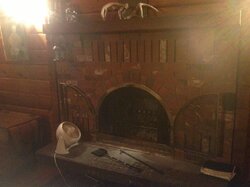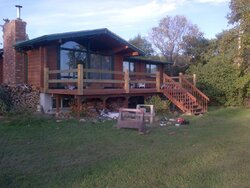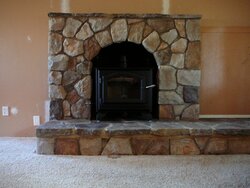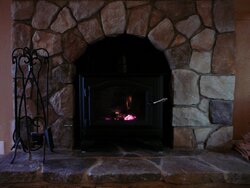Fellow Hearth Members.
Following a fairly challenging set back in my pursuit of being able to fully heat our home with wood I realize that one thing I have never done is to put a photo of our fireplace up on hearth.com to ask for help. (See image)
This week I met with someone much experienced than I am (a certified chimney builder/expert) who had a look at our existing wood heat appliance ( a drolet non EPA stove in our basement with double wall pipe connected to duravent liner into a 10 inch tile line flue). He also looked at our fireplace. NOTE: another installer approved and signed off on the basement installation. We are working with a new installer due to being connected via a financing program to the new installer.
In both cases he had grave concerns about our installations and essentially has recommended very strongly against our intentions of upgrading the stove in the basement due to his concerns over clearances.
Now what I would like to get feedback on is our fireplace.
Does anyone have experience with changing a fireplace such as ours to an insert installation?
The flue is a ten inch square tile lined flue running up from a corrugated firebox fireplace built right into a masonry chimney.
There are air inlets on either side of the fireplace that move air up and through tubes that pass through the upper portion of the firebox just above the damper.
The chimney builder essentially said that he wouldn't recommend any use of the fireplace at all due to clearance concerns. His strong suggestion was that any effort to simply line the masonry chimney would not meet code.
The equally strong suggestion was made that we should abandon the existing masonry chimney and run a new stainless chimney elsewhere in the home other than trying to do anything with our existing wood stove or with the fireplace.
Any and all advice or suggestions would be appreciated as we don't want to admit defeat.
One idea I want to push with our installer would be to go with an insert and to run an actually chimney, not just a liner, down the 10 inch flue to an insert in the the fireplace.
Looking forward to the ideas and suggestions.


Following a fairly challenging set back in my pursuit of being able to fully heat our home with wood I realize that one thing I have never done is to put a photo of our fireplace up on hearth.com to ask for help. (See image)
This week I met with someone much experienced than I am (a certified chimney builder/expert) who had a look at our existing wood heat appliance ( a drolet non EPA stove in our basement with double wall pipe connected to duravent liner into a 10 inch tile line flue). He also looked at our fireplace. NOTE: another installer approved and signed off on the basement installation. We are working with a new installer due to being connected via a financing program to the new installer.
In both cases he had grave concerns about our installations and essentially has recommended very strongly against our intentions of upgrading the stove in the basement due to his concerns over clearances.
Now what I would like to get feedback on is our fireplace.
Does anyone have experience with changing a fireplace such as ours to an insert installation?
The flue is a ten inch square tile lined flue running up from a corrugated firebox fireplace built right into a masonry chimney.
There are air inlets on either side of the fireplace that move air up and through tubes that pass through the upper portion of the firebox just above the damper.
The chimney builder essentially said that he wouldn't recommend any use of the fireplace at all due to clearance concerns. His strong suggestion was that any effort to simply line the masonry chimney would not meet code.
The equally strong suggestion was made that we should abandon the existing masonry chimney and run a new stainless chimney elsewhere in the home other than trying to do anything with our existing wood stove or with the fireplace.
Any and all advice or suggestions would be appreciated as we don't want to admit defeat.
One idea I want to push with our installer would be to go with an insert and to run an actually chimney, not just a liner, down the 10 inch flue to an insert in the the fireplace.
Looking forward to the ideas and suggestions.


Last edited by a moderator:



